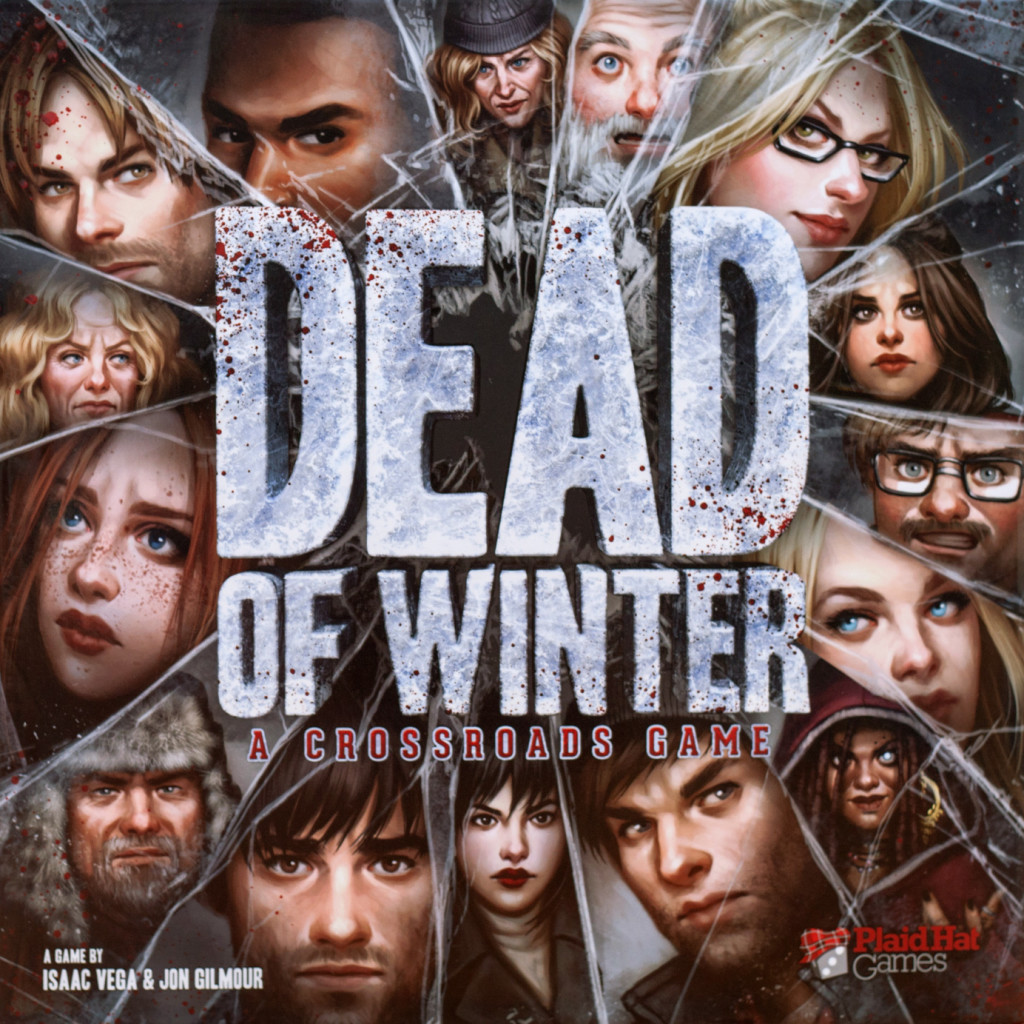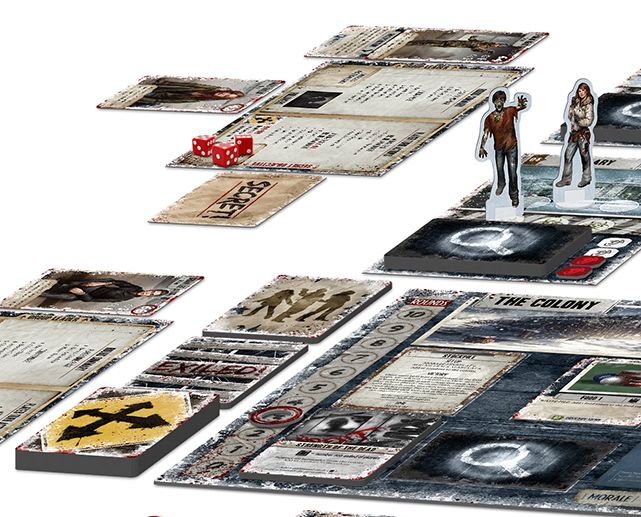In “Dead of Winter”, you and a group of survivors are trying to survive the harsh winter in the aftermath of the zombie apocalypse. Players will be receiving a secret objective that they’ll need to complete, on top of the colony goal chosen each game. Some secret objectives even involve being a hidden traitor, tasking owners to throw the game any way they can without being discovered. To top that off, your group of players are also responsible for more people than just yourselves…meaning you’ll have to endeavor to keep your no-named colonists fed each round while being sure to clean up the trash afterwards (literally). Only the strong will survive…maybe.
Components
The game includes 10 – Dual-Sided Main Objective Cards, 24 – Secret Objective Cards, 10 – Betrayal Secret Objective Cards, 10 – Exiled Secret Objective Cards, 30 – Survivor Cards, 5 – Player Reference Sheets, 1 – First Player Token, 25 – Starting Item Cards, 20 – Police Station Item Deck Cards, 20 – Grocery Store Item Deck Cards, 20 – School Item Deck Cards, 20 – Gas Station Item Deck Cards, 20 – Library Item Deck Cards, 20 – Hospital Item Deck Cards, 20 – Crisis Cards, 80 – Crossroads Cards, 25 – Wound Tokens, 20 – Helpless Survivor Tokens, 20 – Food Tokens, 20 – Noise Tokens, 20 – Barricade Tokens, 6 – Starvation Tokens, 2 – Track Markers, 30 – Zombie Standees, 30 – Zombie Tokens (use if you run out of standees), 30 – Survivor Standees, 60 – Plastic Standee Stands, 1 – Colony Board, 6 – Location Cards, 1 – Rulebook, 30 – Action Dice, 1 – Exposure Die
Setup & Gameplay
The game can be played a number of different ways and can be pretty involved, so I’ll opt to skip game setup in order to keep things moving. I will offer however that the game can be played cooperatively with or without a traitor mechanic. In the case of the latter (known as the co-op variant), players do not receive secret objectives but use the hardcore side of the main objective card. In the two player variant, the co-op rules are observed though players get seven cards instead of five and four survivors instead of three. Betrayer, hardcore, and player elimination variants make the game even more challenging.
The game is played over a series of rounds (the number of which is determined by the main objective card chosen during setup) and each round consists of two phases: 1) Player Turns Phase and the 2) Colony Phase.
Player Turns Phase
At the beginning of a player’s turn, the player to the right of the active player will draw a crossroads card and keep its contents secret. It’ll be revealed only if the active player triggers the effect listed on the card.
1. Reveal Crisis – The top card of the crisis deck is revealed.
2. Roll Action Dice – Each player rolls their dice. They should have one die for each survivor, plus one.
3. Player Turns – Each player, starting with the first player, takes their turn by taking actions. Some actions require dice, others do not. Players can attack zombies, attack other players, search a location, barricade, clean waste, attract, use a survivor ability, play a card, add cards to the crisis (face-down), move a survivor, spend food tokens, request, hand off, and vote to exile.
Colony Phase
1. Pay Food – Every two survivors in the colony needs one food token. If you have enough food, then the appropriate number of tokens are removed. Otherwise, they stay there however a starvation token is added, dropping morale.
2. Check Waste – Morale drops by one for every ten cards in the waste pile.
3. Resolve Crisis – The cards contributed to the crisis are shuffled and revealed. Cards not matching the needed item type count against your total. If the crisis is not prevented, then you’ll follow the instructions on the card.
4. Add Zombies – One zombie is added to the colony for every two survivors present there. One zombie is added at every non-colony location for every one survivor present. Noise tokens are resolved and if appropriate, more zombies are added.
5. Check Main Objective – If the main objective is completed, the game ends.
6. Move Round Tracker – The tracker moves down by one. When the round tracker is zero, the game ends.
7. Pass First Player Token – The first player token is passed counter-clockwise.
If morale at any point reaches zero, the game ends in failure. Morale can be lost a number of ways, like when survivors die or through starvation. When a player loses all of their survivors, they’ll discard their entire hand and choose a new survivor from the deck. Rounds continue until a game ending condition is met. The only players who win are those who completed their secret objective.
Editor’s Note: The above doesn’t cover all of the rules found in the manual, but should give you an idea as to how the game is played.
The Review
“Battlestar Galactica” meets zombies…at least, that’s what came to mind the moment I finished reading the manual. Like “Battlestar Galactica”, all players will be contributing cards toward a crisis goal from round to round, trying to stave off zombies in the process. Of course, cards contributed this way are done so face down, giving the traitor (if there is one) a chance to really mess things up. It’s worth noting that the secret objectives (and thus the traitor mechanic) are only utilized if you have three or more players. Two players automatically apply the pure co-op variant with a few rule changes to balance things.
Speaking of variants, I appreciate that the game gives you multiple ways to play. The manual lists a co-op variant, hardcore variant, betrayer variant, and player elimination variant, though you can alter the rules as you see fit. I myself prefer a more casual experience, so flipping the objective card to the normal side even while playing co-op is a possibility. You could also try adding more survivors to the mix giving everyone more dice to roll on their turns, though food demands will go up as a result. Even when playing via the core rules, the game includes multiple scenarios ranging in both difficulty and play time.
The game itself is incredibly thematic with the artwork being above average. It also came with a LOT of baggies, which I’m thankful for as there are a lot of little pieces/tokens. The learning curve is rather high, I feel, as there are a lot of things to remember while playing out a round. The player reference boards do help, but you’ll often be forced to flip through the manual for something specific. The number of actions alone is staggering, so be sure to allot extra play time for your first few games. The game can seem punishing to the uninitiated, so my advice is to be patient and cheat a little if you must if your group gets frustrated easily. I say this because some gamers really enjoy learning as they go and being defeated mercilessly in the process, while others do not.
As with any cooperative game, a player who likes to control things or is just an asshat overall will more than likely ruin the experience for everyone else. On the other hand, this game is will leave you wanting more if you get the right group together…especially if you include the secret objectives and have a suspected traitor in your midst. The game can be incredibly fun and nail-bitingly tense when you realize that the only person you can trust is yourself, but are forced to work together with others anyway to prevent crisis cards from repeatedly failing. Of course, that may be a good thing if you end up being the traitor yourself.
As an experienced yet casual gamer who enjoys cooperative experiences, I can recommend this one. Just be forewarned that learning the game can take some time and there are some cards with adult themes (though they can be removed beforehand).
Final Verdict: 9/10
—


